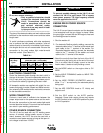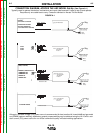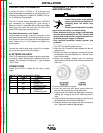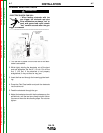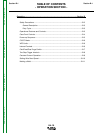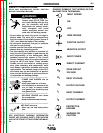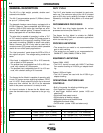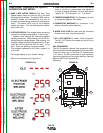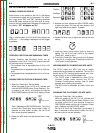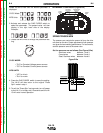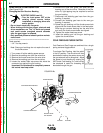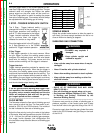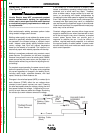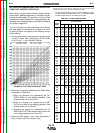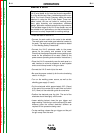
OPERATION
LN-15
B-4 B-4
Return to Section TOC Return to Section TOC Return to Section TOC Return to Section TOC
Return to Master TOC Return to Master TOC Return to Master TOC Return to Master TOC
1
2
3
4
5
6
7
3. WIRE FEED SPEED KNOB
-
The Wire Feed Speed
knob is a 3-3/4 turn potentiometer that adjusts of
the rate of feeding electrode. The wire feed speed
range is 50 - 700 inches/min (1.3 - 17.8 m/min)
4. TRIGGER CONNECTOR-5 Pin Receptacle is used
to activate the Magnum Gun Switch.
5. CONNECTOR BUSHING-This connection is for
welding conductor cable assembly.
6. WORK CLIP LEAD-This lead must be connected
directly to the work using the spring clip.
7. ON / OFF SWITCH-For codes 11033 and above:
The ON / OFF Switch turns power on and off to the
wire feeder.
83% PROCEDURE
The LN-15 supports a special "dual procedure" mode.
When activated, the wire feed speed is reduced to 83%
of the set value, but no less than 50 inches/minute
(1.27 m/min). The 83% procedure is most commonly
used during pipe and out of position welding. Requires
Magnum 400 Dual Procedure Gun
Equivalent.
FIGURE B.1
CASE FRONT CONTROLS
(See Figure B.1)
ACROSS THE ARC MODEL
1. WIRE FEED SPEED DISPLAY-The Wire Feed
Speed display shows the rate the LN-15 will feed
electrode during welding. The default WFS units for
domestic models are inches/minute and can be
changed to meters/minute through the configuration
menu. The default WFS units for the European
models are m/min. The wire feed speed is calibrat-
ed to within ±2%.
2. VOLTAGE DISPLAY
-
The voltage display shows the
average arc voltage during welding. A minus sign "-
" appears when welding with electrode negative
welding procedures. While welding, an LED will illu-
minate below the voltage display. After welding, the
average voltage will continue to be shown for 5 sec-
onds after the end and the LED will flash. of the
weld. When not welding, the display shows "- - - ".
The voltage is calibrated to ±2% over a range of 10
to 45 volts.
The voltage display is not a "preset" voltage.
Refer to the examples from Figure B.1a.
FIGURE B.1a



